Developing a Comprehensive Care Plan for AMI Patient, Violet Paterson
VerifiedAdded on 2020/12/10
|10
|3665
|279
Report
AI Summary
This report provides a comprehensive care plan for a 77-year-old female patient, Miss Violet Paterson, admitted with an Acute Myocardial Infarction (AMI) and a history of hypertension and osteoarthritis. The report details the considerations for patient care, emphasizing the application of the clinical reasoning cycle. It identifies crucial nursing assessments, including the use of the OLDCART methodology and regular physical examinations, and explains their priority. Three priority nursing diagnoses are established, focusing on monitoring vital signs, managing cholesterol levels, and implementing exercise plans. The report further outlines patient education required post-discharge, particularly regarding AMI symptoms and lifestyle modifications. Finally, it defines the Allied Health team members, such as exercise physiologists and counselors, essential for the patient's care during admission and discharge preparation. The report underscores the importance of holistic care, addressing physical, social, and psychological needs to improve the patient's quality of life and prevent future cardiac events.
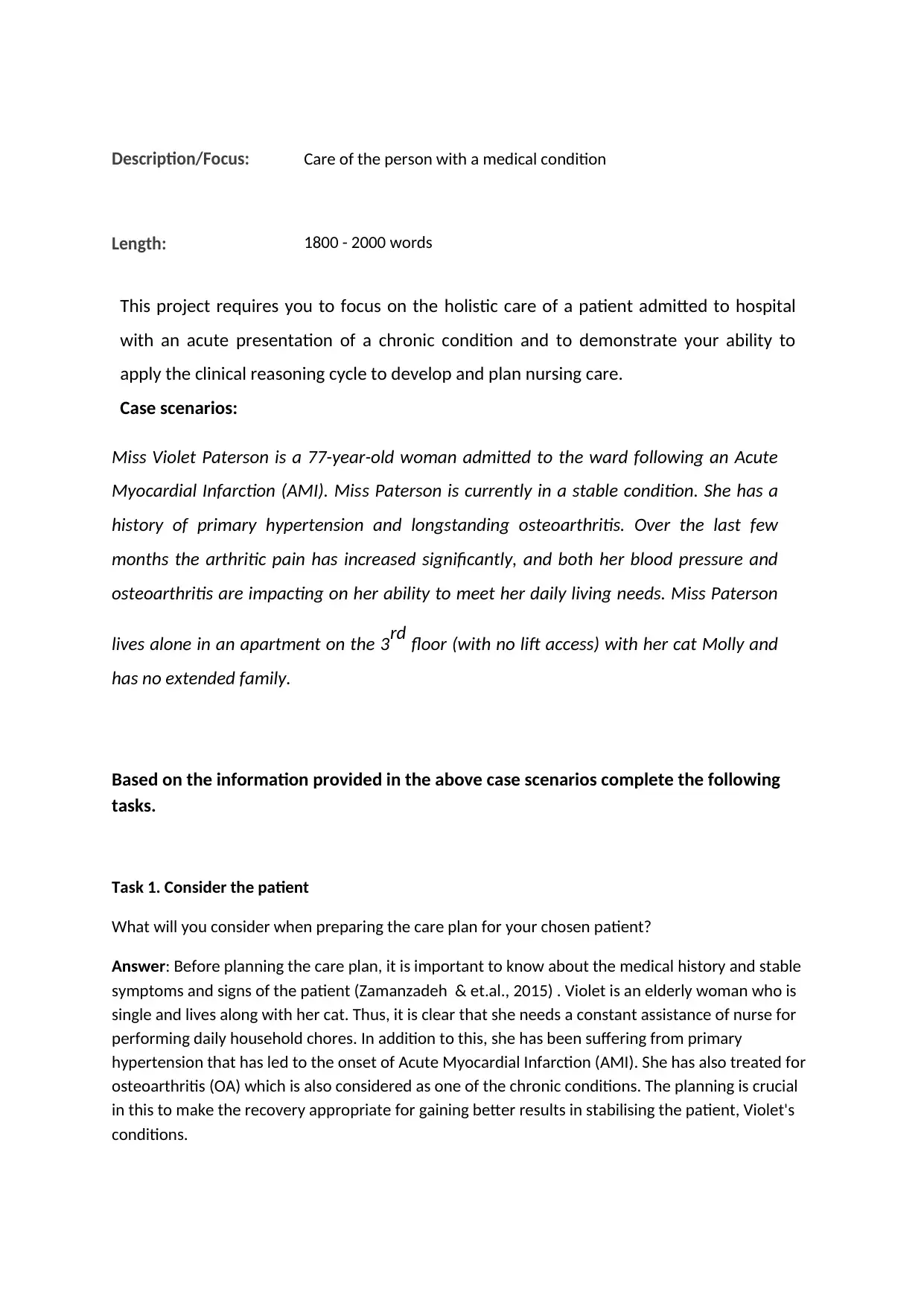
Description/Focus: Care of the person with a medical condition
Length: 1800 - 2000 words
This project requires you to focus on the holistic care of a patient admitted to hospital
with an acute presentation of a chronic condition and to demonstrate your ability to
apply the clinical reasoning cycle to develop and plan nursing care.
Case scenarios:
Miss Violet Paterson is a 77-year-old woman admitted to the ward following an Acute
Myocardial Infarction (AMI). Miss Paterson is currently in a stable condition. She has a
history of primary hypertension and longstanding osteoarthritis. Over the last few
months the arthritic pain has increased significantly, and both her blood pressure and
osteoarthritis are impacting on her ability to meet her daily living needs. Miss Paterson
lives alone in an apartment on the 3rd floor (with no lift access) with her cat Molly and
has no extended family.
Based on the information provided in the above case scenarios complete the following
tasks.
Task 1. Consider the patient
What will you consider when preparing the care plan for your chosen patient?
Answer: Before planning the care plan, it is important to know about the medical history and stable
symptoms and signs of the patient (Zamanzadeh & et.al., 2015) . Violet is an elderly woman who is
single and lives along with her cat. Thus, it is clear that she needs a constant assistance of nurse for
performing daily household chores. In addition to this, she has been suffering from primary
hypertension that has led to the onset of Acute Myocardial Infarction (AMI). She has also treated for
osteoarthritis (OA) which is also considered as one of the chronic conditions. The planning is crucial
in this to make the recovery appropriate for gaining better results in stabilising the patient, Violet's
conditions.
Length: 1800 - 2000 words
This project requires you to focus on the holistic care of a patient admitted to hospital
with an acute presentation of a chronic condition and to demonstrate your ability to
apply the clinical reasoning cycle to develop and plan nursing care.
Case scenarios:
Miss Violet Paterson is a 77-year-old woman admitted to the ward following an Acute
Myocardial Infarction (AMI). Miss Paterson is currently in a stable condition. She has a
history of primary hypertension and longstanding osteoarthritis. Over the last few
months the arthritic pain has increased significantly, and both her blood pressure and
osteoarthritis are impacting on her ability to meet her daily living needs. Miss Paterson
lives alone in an apartment on the 3rd floor (with no lift access) with her cat Molly and
has no extended family.
Based on the information provided in the above case scenarios complete the following
tasks.
Task 1. Consider the patient
What will you consider when preparing the care plan for your chosen patient?
Answer: Before planning the care plan, it is important to know about the medical history and stable
symptoms and signs of the patient (Zamanzadeh & et.al., 2015) . Violet is an elderly woman who is
single and lives along with her cat. Thus, it is clear that she needs a constant assistance of nurse for
performing daily household chores. In addition to this, she has been suffering from primary
hypertension that has led to the onset of Acute Myocardial Infarction (AMI). She has also treated for
osteoarthritis (OA) which is also considered as one of the chronic conditions. The planning is crucial
in this to make the recovery appropriate for gaining better results in stabilising the patient, Violet's
conditions.
Paraphrase This Document
Need a fresh take? Get an instant paraphrase of this document with our AI Paraphraser
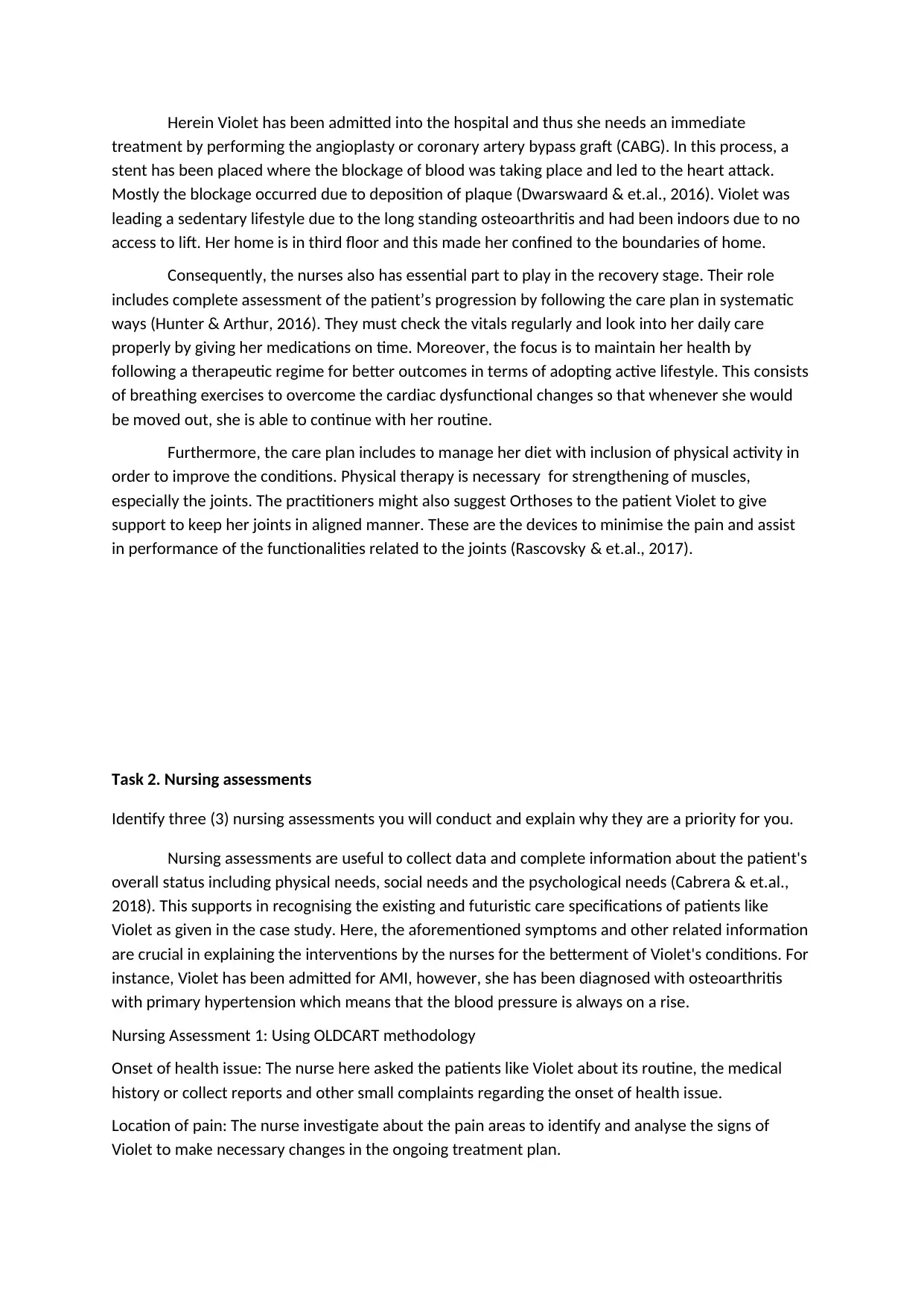
Herein Violet has been admitted into the hospital and thus she needs an immediate
treatment by performing the angioplasty or coronary artery bypass graft (CABG). In this process, a
stent has been placed where the blockage of blood was taking place and led to the heart attack.
Mostly the blockage occurred due to deposition of plaque (Dwarswaard & et.al., 2016). Violet was
leading a sedentary lifestyle due to the long standing osteoarthritis and had been indoors due to no
access to lift. Her home is in third floor and this made her confined to the boundaries of home.
Consequently, the nurses also has essential part to play in the recovery stage. Their role
includes complete assessment of the patient’s progression by following the care plan in systematic
ways (Hunter & Arthur, 2016). They must check the vitals regularly and look into her daily care
properly by giving her medications on time. Moreover, the focus is to maintain her health by
following a therapeutic regime for better outcomes in terms of adopting active lifestyle. This consists
of breathing exercises to overcome the cardiac dysfunctional changes so that whenever she would
be moved out, she is able to continue with her routine.
Furthermore, the care plan includes to manage her diet with inclusion of physical activity in
order to improve the conditions. Physical therapy is necessary for strengthening of muscles,
especially the joints. The practitioners might also suggest Orthoses to the patient Violet to give
support to keep her joints in aligned manner. These are the devices to minimise the pain and assist
in performance of the functionalities related to the joints (Rascovsky & et.al., 2017).
Task 2. Nursing assessments
Identify three (3) nursing assessments you will conduct and explain why they are a priority for you.
Nursing assessments are useful to collect data and complete information about the patient's
overall status including physical needs, social needs and the psychological needs (Cabrera & et.al.,
2018). This supports in recognising the existing and futuristic care specifications of patients like
Violet as given in the case study. Here, the aforementioned symptoms and other related information
are crucial in explaining the interventions by the nurses for the betterment of Violet's conditions. For
instance, Violet has been admitted for AMI, however, she has been diagnosed with osteoarthritis
with primary hypertension which means that the blood pressure is always on a rise.
Nursing Assessment 1: Using OLDCART methodology
Onset of health issue: The nurse here asked the patients like Violet about its routine, the medical
history or collect reports and other small complaints regarding the onset of health issue.
Location of pain: The nurse investigate about the pain areas to identify and analyse the signs of
Violet to make necessary changes in the ongoing treatment plan.
treatment by performing the angioplasty or coronary artery bypass graft (CABG). In this process, a
stent has been placed where the blockage of blood was taking place and led to the heart attack.
Mostly the blockage occurred due to deposition of plaque (Dwarswaard & et.al., 2016). Violet was
leading a sedentary lifestyle due to the long standing osteoarthritis and had been indoors due to no
access to lift. Her home is in third floor and this made her confined to the boundaries of home.
Consequently, the nurses also has essential part to play in the recovery stage. Their role
includes complete assessment of the patient’s progression by following the care plan in systematic
ways (Hunter & Arthur, 2016). They must check the vitals regularly and look into her daily care
properly by giving her medications on time. Moreover, the focus is to maintain her health by
following a therapeutic regime for better outcomes in terms of adopting active lifestyle. This consists
of breathing exercises to overcome the cardiac dysfunctional changes so that whenever she would
be moved out, she is able to continue with her routine.
Furthermore, the care plan includes to manage her diet with inclusion of physical activity in
order to improve the conditions. Physical therapy is necessary for strengthening of muscles,
especially the joints. The practitioners might also suggest Orthoses to the patient Violet to give
support to keep her joints in aligned manner. These are the devices to minimise the pain and assist
in performance of the functionalities related to the joints (Rascovsky & et.al., 2017).
Task 2. Nursing assessments
Identify three (3) nursing assessments you will conduct and explain why they are a priority for you.
Nursing assessments are useful to collect data and complete information about the patient's
overall status including physical needs, social needs and the psychological needs (Cabrera & et.al.,
2018). This supports in recognising the existing and futuristic care specifications of patients like
Violet as given in the case study. Here, the aforementioned symptoms and other related information
are crucial in explaining the interventions by the nurses for the betterment of Violet's conditions. For
instance, Violet has been admitted for AMI, however, she has been diagnosed with osteoarthritis
with primary hypertension which means that the blood pressure is always on a rise.
Nursing Assessment 1: Using OLDCART methodology
Onset of health issue: The nurse here asked the patients like Violet about its routine, the medical
history or collect reports and other small complaints regarding the onset of health issue.
Location of pain: The nurse investigate about the pain areas to identify and analyse the signs of
Violet to make necessary changes in the ongoing treatment plan.
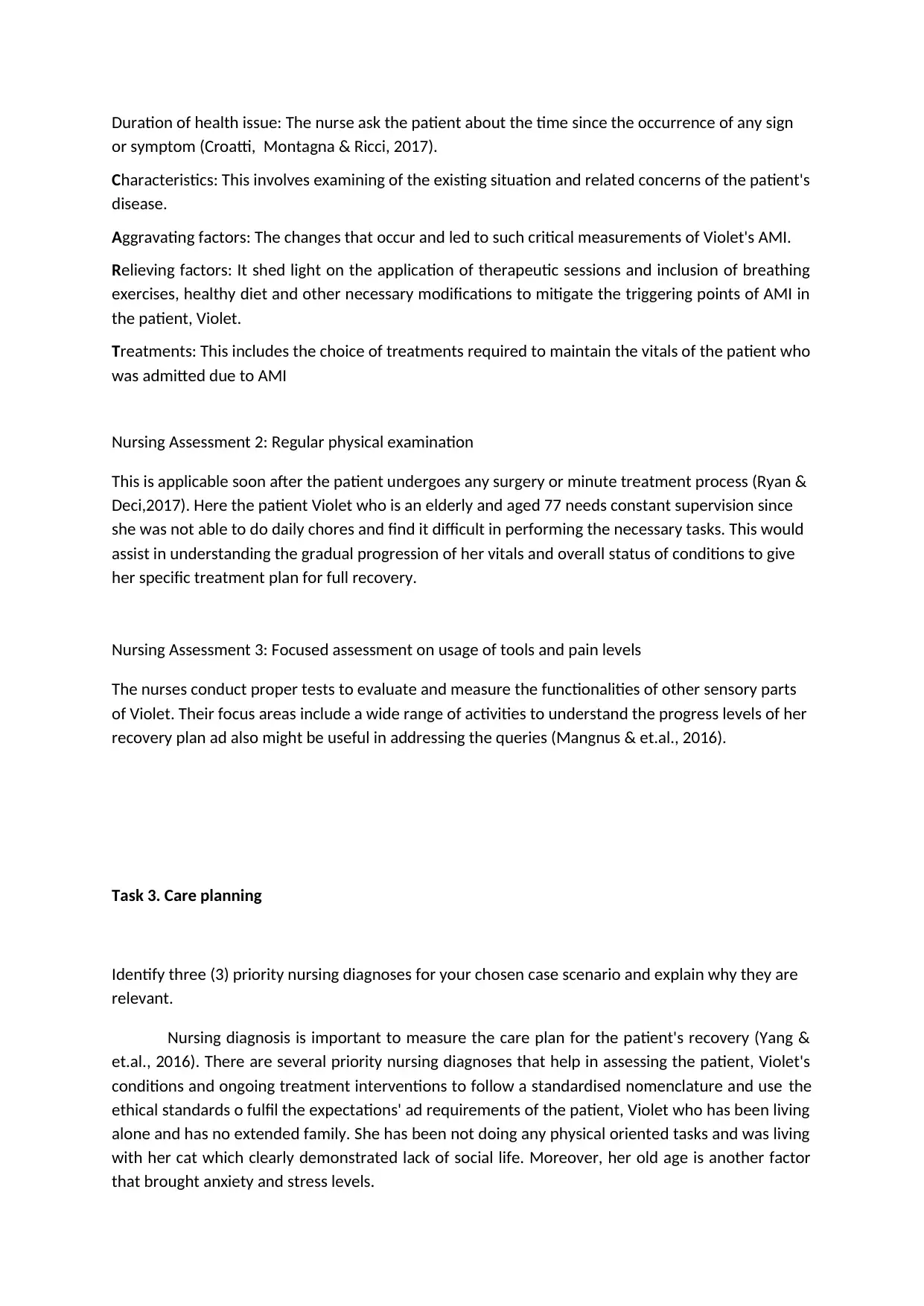
Duration of health issue: The nurse ask the patient about the time since the occurrence of any sign
or symptom (Croatti, Montagna & Ricci, 2017).
Characteristics: This involves examining of the existing situation and related concerns of the patient's
disease.
Aggravating factors: The changes that occur and led to such critical measurements of Violet's AMI.
Relieving factors: It shed light on the application of therapeutic sessions and inclusion of breathing
exercises, healthy diet and other necessary modifications to mitigate the triggering points of AMI in
the patient, Violet.
Treatments: This includes the choice of treatments required to maintain the vitals of the patient who
was admitted due to AMI
Nursing Assessment 2: Regular physical examination
This is applicable soon after the patient undergoes any surgery or minute treatment process (Ryan &
Deci,2017). Here the patient Violet who is an elderly and aged 77 needs constant supervision since
she was not able to do daily chores and find it difficult in performing the necessary tasks. This would
assist in understanding the gradual progression of her vitals and overall status of conditions to give
her specific treatment plan for full recovery.
Nursing Assessment 3: Focused assessment on usage of tools and pain levels
The nurses conduct proper tests to evaluate and measure the functionalities of other sensory parts
of Violet. Their focus areas include a wide range of activities to understand the progress levels of her
recovery plan ad also might be useful in addressing the queries (Mangnus & et.al., 2016).
Task 3. Care planning
Identify three (3) priority nursing diagnoses for your chosen case scenario and explain why they are
relevant.
Nursing diagnosis is important to measure the care plan for the patient's recovery (Yang &
et.al., 2016). There are several priority nursing diagnoses that help in assessing the patient, Violet's
conditions and ongoing treatment interventions to follow a standardised nomenclature and use the
ethical standards o fulfil the expectations' ad requirements of the patient, Violet who has been living
alone and has no extended family. She has been not doing any physical oriented tasks and was living
with her cat which clearly demonstrated lack of social life. Moreover, her old age is another factor
that brought anxiety and stress levels.
or symptom (Croatti, Montagna & Ricci, 2017).
Characteristics: This involves examining of the existing situation and related concerns of the patient's
disease.
Aggravating factors: The changes that occur and led to such critical measurements of Violet's AMI.
Relieving factors: It shed light on the application of therapeutic sessions and inclusion of breathing
exercises, healthy diet and other necessary modifications to mitigate the triggering points of AMI in
the patient, Violet.
Treatments: This includes the choice of treatments required to maintain the vitals of the patient who
was admitted due to AMI
Nursing Assessment 2: Regular physical examination
This is applicable soon after the patient undergoes any surgery or minute treatment process (Ryan &
Deci,2017). Here the patient Violet who is an elderly and aged 77 needs constant supervision since
she was not able to do daily chores and find it difficult in performing the necessary tasks. This would
assist in understanding the gradual progression of her vitals and overall status of conditions to give
her specific treatment plan for full recovery.
Nursing Assessment 3: Focused assessment on usage of tools and pain levels
The nurses conduct proper tests to evaluate and measure the functionalities of other sensory parts
of Violet. Their focus areas include a wide range of activities to understand the progress levels of her
recovery plan ad also might be useful in addressing the queries (Mangnus & et.al., 2016).
Task 3. Care planning
Identify three (3) priority nursing diagnoses for your chosen case scenario and explain why they are
relevant.
Nursing diagnosis is important to measure the care plan for the patient's recovery (Yang &
et.al., 2016). There are several priority nursing diagnoses that help in assessing the patient, Violet's
conditions and ongoing treatment interventions to follow a standardised nomenclature and use the
ethical standards o fulfil the expectations' ad requirements of the patient, Violet who has been living
alone and has no extended family. She has been not doing any physical oriented tasks and was living
with her cat which clearly demonstrated lack of social life. Moreover, her old age is another factor
that brought anxiety and stress levels.
⊘ This is a preview!⊘
Do you want full access?
Subscribe today to unlock all pages.

Trusted by 1+ million students worldwide
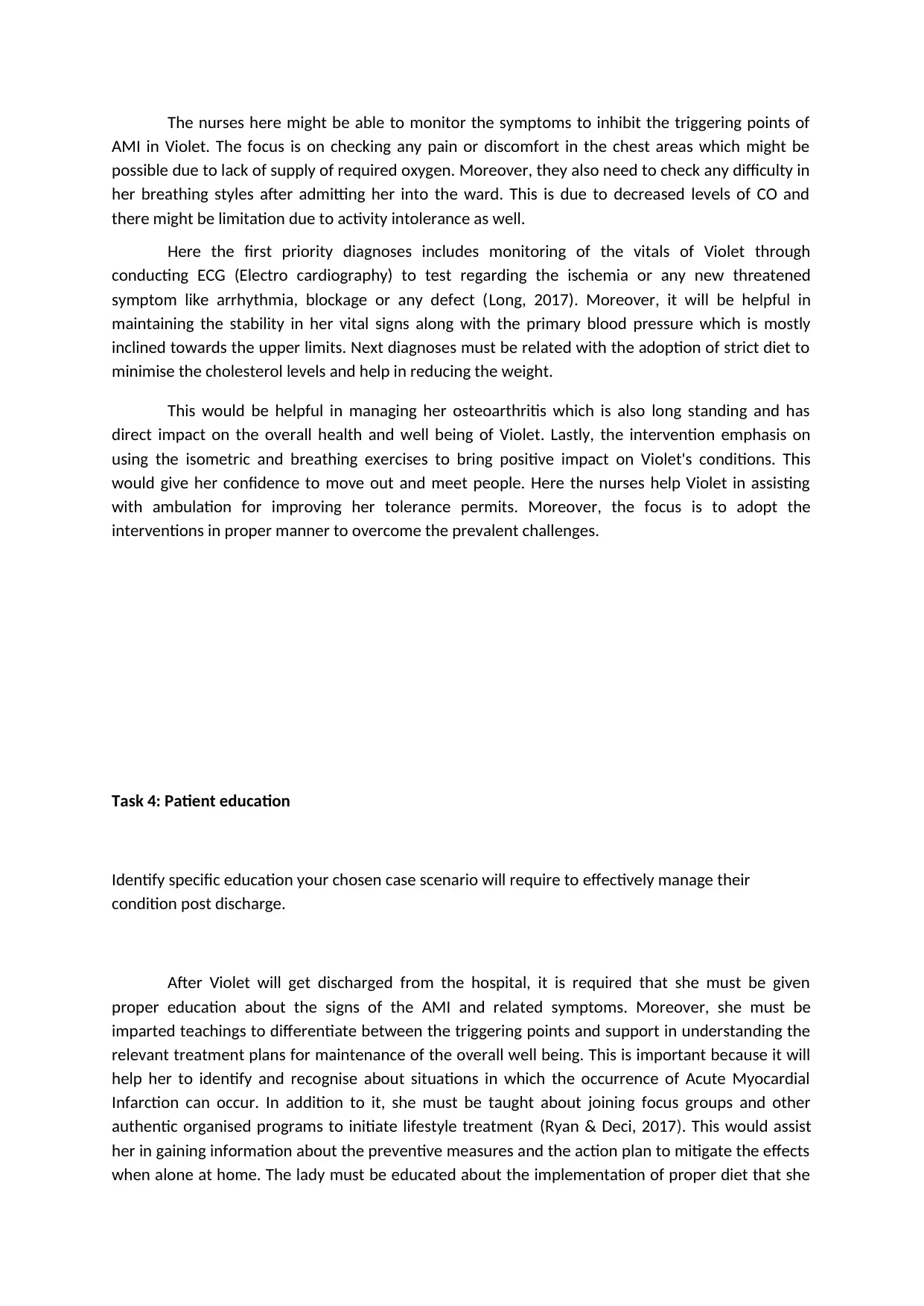
The nurses here might be able to monitor the symptoms to inhibit the triggering points of
AMI in Violet. The focus is on checking any pain or discomfort in the chest areas which might be
possible due to lack of supply of required oxygen. Moreover, they also need to check any difficulty in
her breathing styles after admitting her into the ward. This is due to decreased levels of CO and
there might be limitation due to activity intolerance as well.
Here the first priority diagnoses includes monitoring of the vitals of Violet through
conducting ECG (Electro cardiography) to test regarding the ischemia or any new threatened
symptom like arrhythmia, blockage or any defect (Long, 2017). Moreover, it will be helpful in
maintaining the stability in her vital signs along with the primary blood pressure which is mostly
inclined towards the upper limits. Next diagnoses must be related with the adoption of strict diet to
minimise the cholesterol levels and help in reducing the weight.
This would be helpful in managing her osteoarthritis which is also long standing and has
direct impact on the overall health and well being of Violet. Lastly, the intervention emphasis on
using the isometric and breathing exercises to bring positive impact on Violet's conditions. This
would give her confidence to move out and meet people. Here the nurses help Violet in assisting
with ambulation for improving her tolerance permits. Moreover, the focus is to adopt the
interventions in proper manner to overcome the prevalent challenges.
Task 4: Patient education
Identify specific education your chosen case scenario will require to effectively manage their
condition post discharge.
After Violet will get discharged from the hospital, it is required that she must be given
proper education about the signs of the AMI and related symptoms. Moreover, she must be
imparted teachings to differentiate between the triggering points and support in understanding the
relevant treatment plans for maintenance of the overall well being. This is important because it will
help her to identify and recognise about situations in which the occurrence of Acute Myocardial
Infarction can occur. In addition to it, she must be taught about joining focus groups and other
authentic organised programs to initiate lifestyle treatment (Ryan & Deci, 2017). This would assist
her in gaining information about the preventive measures and the action plan to mitigate the effects
when alone at home. The lady must be educated about the implementation of proper diet that she
AMI in Violet. The focus is on checking any pain or discomfort in the chest areas which might be
possible due to lack of supply of required oxygen. Moreover, they also need to check any difficulty in
her breathing styles after admitting her into the ward. This is due to decreased levels of CO and
there might be limitation due to activity intolerance as well.
Here the first priority diagnoses includes monitoring of the vitals of Violet through
conducting ECG (Electro cardiography) to test regarding the ischemia or any new threatened
symptom like arrhythmia, blockage or any defect (Long, 2017). Moreover, it will be helpful in
maintaining the stability in her vital signs along with the primary blood pressure which is mostly
inclined towards the upper limits. Next diagnoses must be related with the adoption of strict diet to
minimise the cholesterol levels and help in reducing the weight.
This would be helpful in managing her osteoarthritis which is also long standing and has
direct impact on the overall health and well being of Violet. Lastly, the intervention emphasis on
using the isometric and breathing exercises to bring positive impact on Violet's conditions. This
would give her confidence to move out and meet people. Here the nurses help Violet in assisting
with ambulation for improving her tolerance permits. Moreover, the focus is to adopt the
interventions in proper manner to overcome the prevalent challenges.
Task 4: Patient education
Identify specific education your chosen case scenario will require to effectively manage their
condition post discharge.
After Violet will get discharged from the hospital, it is required that she must be given
proper education about the signs of the AMI and related symptoms. Moreover, she must be
imparted teachings to differentiate between the triggering points and support in understanding the
relevant treatment plans for maintenance of the overall well being. This is important because it will
help her to identify and recognise about situations in which the occurrence of Acute Myocardial
Infarction can occur. In addition to it, she must be taught about joining focus groups and other
authentic organised programs to initiate lifestyle treatment (Ryan & Deci, 2017). This would assist
her in gaining information about the preventive measures and the action plan to mitigate the effects
when alone at home. The lady must be educated about the implementation of proper diet that she
Paraphrase This Document
Need a fresh take? Get an instant paraphrase of this document with our AI Paraphraser
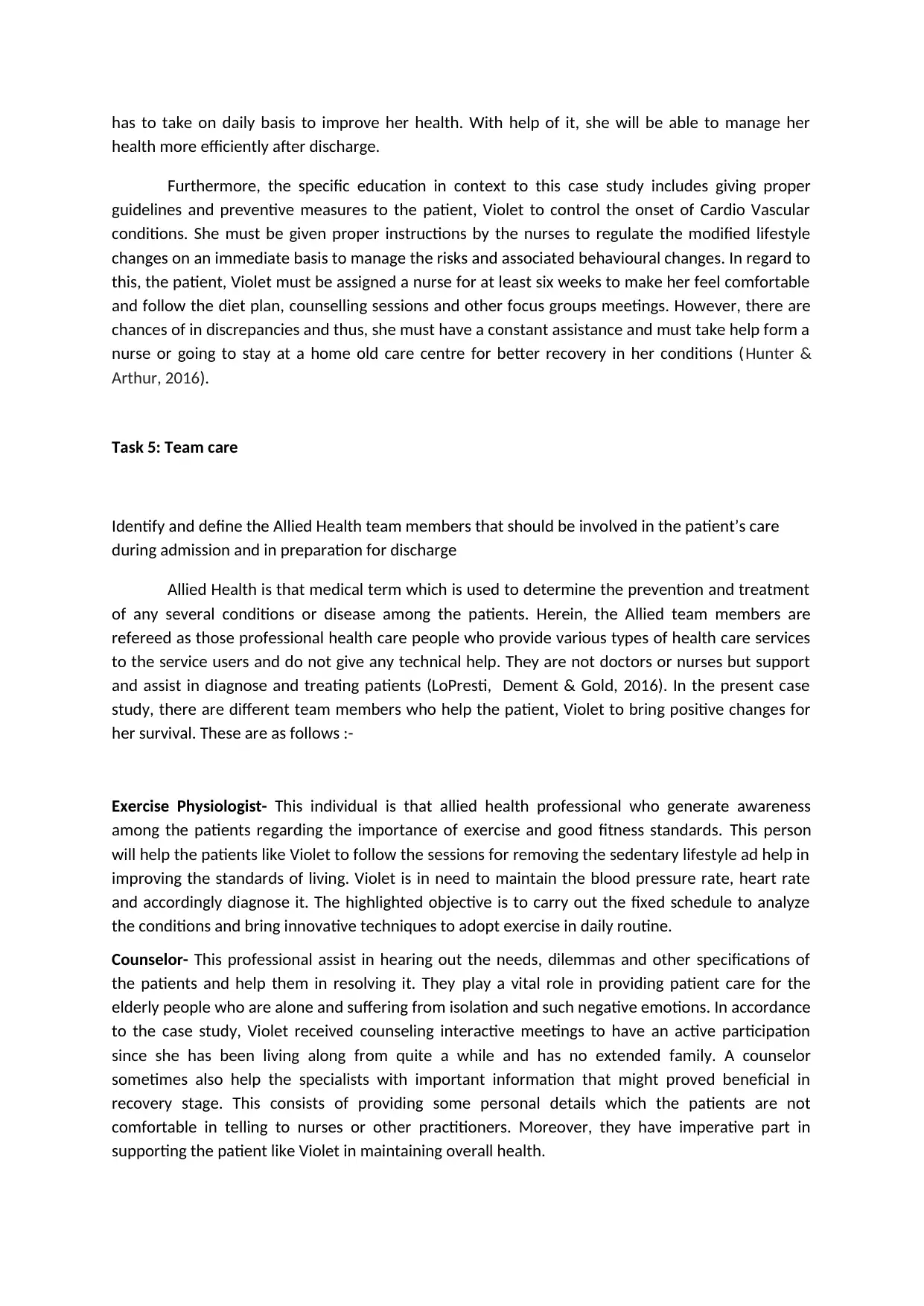
has to take on daily basis to improve her health. With help of it, she will be able to manage her
health more efficiently after discharge.
Furthermore, the specific education in context to this case study includes giving proper
guidelines and preventive measures to the patient, Violet to control the onset of Cardio Vascular
conditions. She must be given proper instructions by the nurses to regulate the modified lifestyle
changes on an immediate basis to manage the risks and associated behavioural changes. In regard to
this, the patient, Violet must be assigned a nurse for at least six weeks to make her feel comfortable
and follow the diet plan, counselling sessions and other focus groups meetings. However, there are
chances of in discrepancies and thus, she must have a constant assistance and must take help form a
nurse or going to stay at a home old care centre for better recovery in her conditions (Hunter &
Arthur, 2016).
Task 5: Team care
Identify and define the Allied Health team members that should be involved in the patient’s care
during admission and in preparation for discharge
Allied Health is that medical term which is used to determine the prevention and treatment
of any several conditions or disease among the patients. Herein, the Allied team members are
refereed as those professional health care people who provide various types of health care services
to the service users and do not give any technical help. They are not doctors or nurses but support
and assist in diagnose and treating patients (LoPresti, Dement & Gold, 2016). In the present case
study, there are different team members who help the patient, Violet to bring positive changes for
her survival. These are as follows :-
Exercise Physiologist- This individual is that allied health professional who generate awareness
among the patients regarding the importance of exercise and good fitness standards. This person
will help the patients like Violet to follow the sessions for removing the sedentary lifestyle ad help in
improving the standards of living. Violet is in need to maintain the blood pressure rate, heart rate
and accordingly diagnose it. The highlighted objective is to carry out the fixed schedule to analyze
the conditions and bring innovative techniques to adopt exercise in daily routine.
Counselor- This professional assist in hearing out the needs, dilemmas and other specifications of
the patients and help them in resolving it. They play a vital role in providing patient care for the
elderly people who are alone and suffering from isolation and such negative emotions. In accordance
to the case study, Violet received counseling interactive meetings to have an active participation
since she has been living along from quite a while and has no extended family. A counselor
sometimes also help the specialists with important information that might proved beneficial in
recovery stage. This consists of providing some personal details which the patients are not
comfortable in telling to nurses or other practitioners. Moreover, they have imperative part in
supporting the patient like Violet in maintaining overall health.
health more efficiently after discharge.
Furthermore, the specific education in context to this case study includes giving proper
guidelines and preventive measures to the patient, Violet to control the onset of Cardio Vascular
conditions. She must be given proper instructions by the nurses to regulate the modified lifestyle
changes on an immediate basis to manage the risks and associated behavioural changes. In regard to
this, the patient, Violet must be assigned a nurse for at least six weeks to make her feel comfortable
and follow the diet plan, counselling sessions and other focus groups meetings. However, there are
chances of in discrepancies and thus, she must have a constant assistance and must take help form a
nurse or going to stay at a home old care centre for better recovery in her conditions (Hunter &
Arthur, 2016).
Task 5: Team care
Identify and define the Allied Health team members that should be involved in the patient’s care
during admission and in preparation for discharge
Allied Health is that medical term which is used to determine the prevention and treatment
of any several conditions or disease among the patients. Herein, the Allied team members are
refereed as those professional health care people who provide various types of health care services
to the service users and do not give any technical help. They are not doctors or nurses but support
and assist in diagnose and treating patients (LoPresti, Dement & Gold, 2016). In the present case
study, there are different team members who help the patient, Violet to bring positive changes for
her survival. These are as follows :-
Exercise Physiologist- This individual is that allied health professional who generate awareness
among the patients regarding the importance of exercise and good fitness standards. This person
will help the patients like Violet to follow the sessions for removing the sedentary lifestyle ad help in
improving the standards of living. Violet is in need to maintain the blood pressure rate, heart rate
and accordingly diagnose it. The highlighted objective is to carry out the fixed schedule to analyze
the conditions and bring innovative techniques to adopt exercise in daily routine.
Counselor- This professional assist in hearing out the needs, dilemmas and other specifications of
the patients and help them in resolving it. They play a vital role in providing patient care for the
elderly people who are alone and suffering from isolation and such negative emotions. In accordance
to the case study, Violet received counseling interactive meetings to have an active participation
since she has been living along from quite a while and has no extended family. A counselor
sometimes also help the specialists with important information that might proved beneficial in
recovery stage. This consists of providing some personal details which the patients are not
comfortable in telling to nurses or other practitioners. Moreover, they have imperative part in
supporting the patient like Violet in maintaining overall health.

Dietitian- They are the individuals who provide suggestions and professional advice related to the
diet plan of a patient. They assess about nutrition needs and meals that Violet has to take to
maintain her vitals in proper manner. Also, dietitian will give brief details on what daily basis they
have to change their diet. Besides this, they will discuss with the specialized doctor to develop a
proper diet plan to help patients like Violet, who are unable to take care of themselves
independently for quick recovery.
diet plan of a patient. They assess about nutrition needs and meals that Violet has to take to
maintain her vitals in proper manner. Also, dietitian will give brief details on what daily basis they
have to change their diet. Besides this, they will discuss with the specialized doctor to develop a
proper diet plan to help patients like Violet, who are unable to take care of themselves
independently for quick recovery.
⊘ This is a preview!⊘
Do you want full access?
Subscribe today to unlock all pages.

Trusted by 1+ million students worldwide

References
Cabrera, E., & et.al. (2018). Aβ truncated species: Implications for brain clearance mechanisms and
amyloid plaque deposition. Biochimica et Biophysica Acta (BBA)-Molecular Basis of Disease. 1864(1).
208-225.
Croatti, A., Montagna, S., & Ricci, A. (2017). A personal medical digital assistant agent for supporting
human operators in emergency scenarios. In Agents and multi-agent systems for health
care (pp. 59-75). Springer, Cham.
Dwarswaard, J., & et.al. (2016). Self management support from the perspective of patients with a‐
chronic condition: a thematic synthesis of qualitative studies. Health Expectations. 19(2).
194-208.
Hunter, S., & Arthur, C. (2016). Clinical reasoning of nursing students on clinical placement: Clinical
educators' perceptions. Nurse education in practice. 18. 73-79.
Long, B. A. (2017). Addressing a Discovery Tool’s Shortcomings with a Supplemental Health Sciences-
Specific Federated Search Engine. Journal of Electronic Resources in Medical Libraries. 14(3-
4). 101-113.
LoPresti, M. A., Dement, F., & Gold, H. T. (2016). End-of-life care for people with cancer from ethnic
minority groups: a systematic review. American Journal of Hospice and Palliative
Medicine®. 33(3). 291-305.
Mangnus, L., & et.al. (2016). Magnetic Resonance Imaging–Detected Features of Inflammation and
Erosions in Symptom Free Persons From the General Population.‐ Arthritis &
Rheumatology. 68(11). 2593-2602.
Rascovsky, K., & et.al. (2017). Neuropsychiatric symptoms in Latino patients with Alzheimer’s
disease: an analysis of the NACC database (P4. 084).
Ryan, R. M., & Deci, E. L. (2017). Self-determination theory: Basic psychological needs in motivation,
development, and wellness. Guilford Publications.
Yang, Y., & et.al.. (2016). Thermal treatment process for the recovery of valuable metals from spent
lithium-ion batteries. Hydrometallurgy. 165. 390-396.
Zamanzadeh, V., & et.al. (2015). Effective factors in providing holistic care: a qualitative study. Indian
journal of palliative care. 21(2). 214.
Cabrera, E., & et.al. (2018). Aβ truncated species: Implications for brain clearance mechanisms and
amyloid plaque deposition. Biochimica et Biophysica Acta (BBA)-Molecular Basis of Disease. 1864(1).
208-225.
Croatti, A., Montagna, S., & Ricci, A. (2017). A personal medical digital assistant agent for supporting
human operators in emergency scenarios. In Agents and multi-agent systems for health
care (pp. 59-75). Springer, Cham.
Dwarswaard, J., & et.al. (2016). Self management support from the perspective of patients with a‐
chronic condition: a thematic synthesis of qualitative studies. Health Expectations. 19(2).
194-208.
Hunter, S., & Arthur, C. (2016). Clinical reasoning of nursing students on clinical placement: Clinical
educators' perceptions. Nurse education in practice. 18. 73-79.
Long, B. A. (2017). Addressing a Discovery Tool’s Shortcomings with a Supplemental Health Sciences-
Specific Federated Search Engine. Journal of Electronic Resources in Medical Libraries. 14(3-
4). 101-113.
LoPresti, M. A., Dement, F., & Gold, H. T. (2016). End-of-life care for people with cancer from ethnic
minority groups: a systematic review. American Journal of Hospice and Palliative
Medicine®. 33(3). 291-305.
Mangnus, L., & et.al. (2016). Magnetic Resonance Imaging–Detected Features of Inflammation and
Erosions in Symptom Free Persons From the General Population.‐ Arthritis &
Rheumatology. 68(11). 2593-2602.
Rascovsky, K., & et.al. (2017). Neuropsychiatric symptoms in Latino patients with Alzheimer’s
disease: an analysis of the NACC database (P4. 084).
Ryan, R. M., & Deci, E. L. (2017). Self-determination theory: Basic psychological needs in motivation,
development, and wellness. Guilford Publications.
Yang, Y., & et.al.. (2016). Thermal treatment process for the recovery of valuable metals from spent
lithium-ion batteries. Hydrometallurgy. 165. 390-396.
Zamanzadeh, V., & et.al. (2015). Effective factors in providing holistic care: a qualitative study. Indian
journal of palliative care. 21(2). 214.
Paraphrase This Document
Need a fresh take? Get an instant paraphrase of this document with our AI Paraphraser
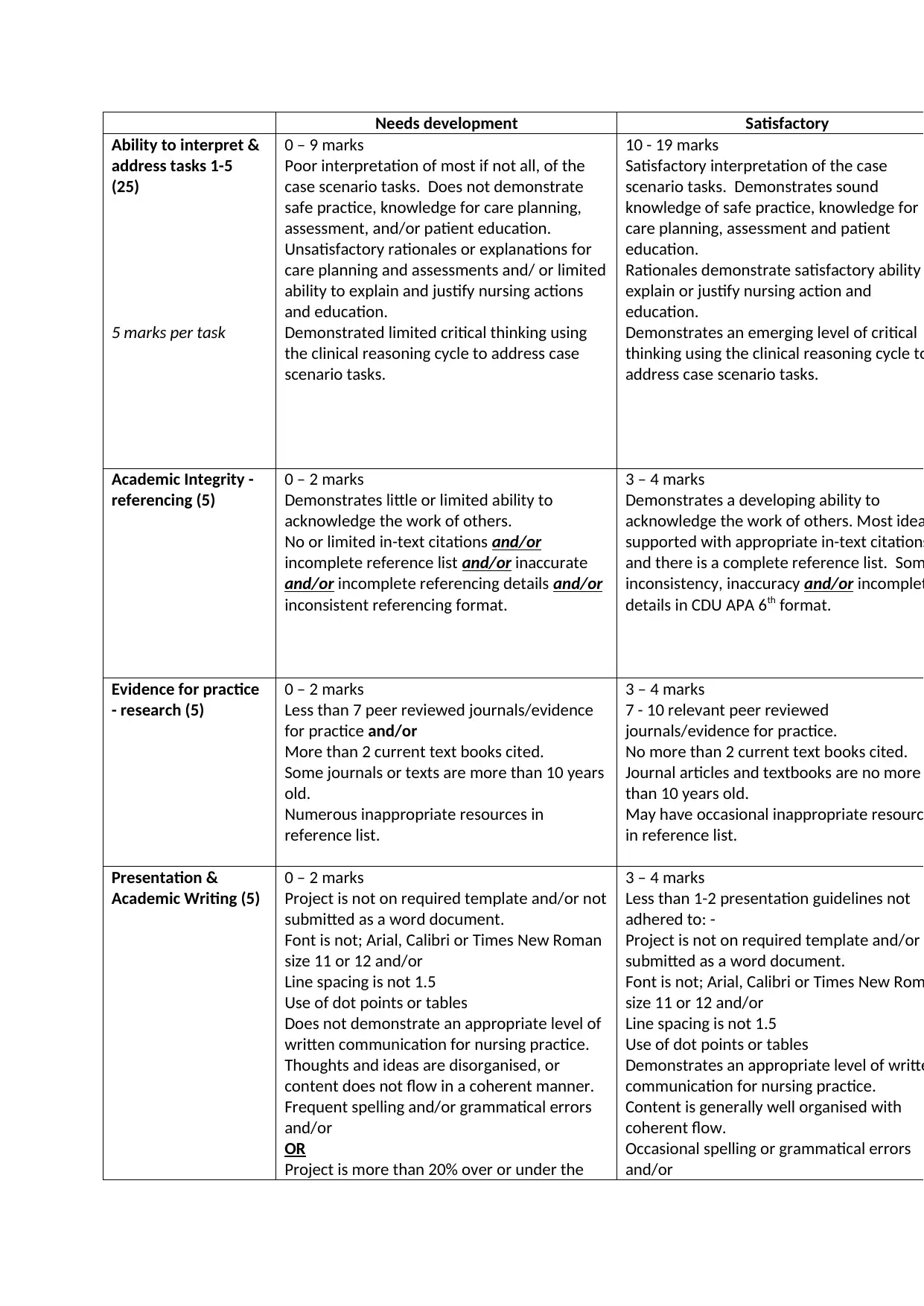
Needs development Satisfactory
Ability to interpret &
address tasks 1-5
(25)
5 marks per task
0 – 9 marks
Poor interpretation of most if not all, of the
case scenario tasks. Does not demonstrate
safe practice, knowledge for care planning,
assessment, and/or patient education.
Unsatisfactory rationales or explanations for
care planning and assessments and/ or limited
ability to explain and justify nursing actions
and education.
Demonstrated limited critical thinking using
the clinical reasoning cycle to address case
scenario tasks.
10 - 19 marks
Satisfactory interpretation of the case
scenario tasks. Demonstrates sound
knowledge of safe practice, knowledge for
care planning, assessment and patient
education.
Rationales demonstrate satisfactory ability
explain or justify nursing action and
education.
Demonstrates an emerging level of critical
thinking using the clinical reasoning cycle to
address case scenario tasks.
Academic Integrity -
referencing (5)
0 – 2 marks
Demonstrates little or limited ability to
acknowledge the work of others.
No or limited in-text citations and/or
incomplete reference list and/or inaccurate
and/or incomplete referencing details and/or
inconsistent referencing format.
3 – 4 marks
Demonstrates a developing ability to
acknowledge the work of others. Most idea
supported with appropriate in-text citations
and there is a complete reference list. Som
inconsistency, inaccuracy and/or incomplet
details in CDU APA 6th format.
Evidence for practice
- research (5)
0 – 2 marks
Less than 7 peer reviewed journals/evidence
for practice and/or
More than 2 current text books cited.
Some journals or texts are more than 10 years
old.
Numerous inappropriate resources in
reference list.
3 – 4 marks
7 - 10 relevant peer reviewed
journals/evidence for practice.
No more than 2 current text books cited.
Journal articles and textbooks are no more
than 10 years old.
May have occasional inappropriate resourc
in reference list.
Presentation &
Academic Writing (5)
0 – 2 marks
Project is not on required template and/or not
submitted as a word document.
Font is not; Arial, Calibri or Times New Roman
size 11 or 12 and/or
Line spacing is not 1.5
Use of dot points or tables
Does not demonstrate an appropriate level of
written communication for nursing practice.
Thoughts and ideas are disorganised, or
content does not flow in a coherent manner.
Frequent spelling and/or grammatical errors
and/or
OR
Project is more than 20% over or under the
3 – 4 marks
Less than 1-2 presentation guidelines not
adhered to: -
Project is not on required template and/or
submitted as a word document.
Font is not; Arial, Calibri or Times New Rom
size 11 or 12 and/or
Line spacing is not 1.5
Use of dot points or tables
Demonstrates an appropriate level of writte
communication for nursing practice.
Content is generally well organised with
coherent flow.
Occasional spelling or grammatical errors
and/or
Ability to interpret &
address tasks 1-5
(25)
5 marks per task
0 – 9 marks
Poor interpretation of most if not all, of the
case scenario tasks. Does not demonstrate
safe practice, knowledge for care planning,
assessment, and/or patient education.
Unsatisfactory rationales or explanations for
care planning and assessments and/ or limited
ability to explain and justify nursing actions
and education.
Demonstrated limited critical thinking using
the clinical reasoning cycle to address case
scenario tasks.
10 - 19 marks
Satisfactory interpretation of the case
scenario tasks. Demonstrates sound
knowledge of safe practice, knowledge for
care planning, assessment and patient
education.
Rationales demonstrate satisfactory ability
explain or justify nursing action and
education.
Demonstrates an emerging level of critical
thinking using the clinical reasoning cycle to
address case scenario tasks.
Academic Integrity -
referencing (5)
0 – 2 marks
Demonstrates little or limited ability to
acknowledge the work of others.
No or limited in-text citations and/or
incomplete reference list and/or inaccurate
and/or incomplete referencing details and/or
inconsistent referencing format.
3 – 4 marks
Demonstrates a developing ability to
acknowledge the work of others. Most idea
supported with appropriate in-text citations
and there is a complete reference list. Som
inconsistency, inaccuracy and/or incomplet
details in CDU APA 6th format.
Evidence for practice
- research (5)
0 – 2 marks
Less than 7 peer reviewed journals/evidence
for practice and/or
More than 2 current text books cited.
Some journals or texts are more than 10 years
old.
Numerous inappropriate resources in
reference list.
3 – 4 marks
7 - 10 relevant peer reviewed
journals/evidence for practice.
No more than 2 current text books cited.
Journal articles and textbooks are no more
than 10 years old.
May have occasional inappropriate resourc
in reference list.
Presentation &
Academic Writing (5)
0 – 2 marks
Project is not on required template and/or not
submitted as a word document.
Font is not; Arial, Calibri or Times New Roman
size 11 or 12 and/or
Line spacing is not 1.5
Use of dot points or tables
Does not demonstrate an appropriate level of
written communication for nursing practice.
Thoughts and ideas are disorganised, or
content does not flow in a coherent manner.
Frequent spelling and/or grammatical errors
and/or
OR
Project is more than 20% over or under the
3 – 4 marks
Less than 1-2 presentation guidelines not
adhered to: -
Project is not on required template and/or
submitted as a word document.
Font is not; Arial, Calibri or Times New Rom
size 11 or 12 and/or
Line spacing is not 1.5
Use of dot points or tables
Demonstrates an appropriate level of writte
communication for nursing practice.
Content is generally well organised with
coherent flow.
Occasional spelling or grammatical errors
and/or

stated word count OR
Project is 10 – 20% over or under the stated
word count
Project is 10 – 20% over or under the stated
word count
⊘ This is a preview!⊘
Do you want full access?
Subscribe today to unlock all pages.

Trusted by 1+ million students worldwide

1 out of 10
Related Documents
Your All-in-One AI-Powered Toolkit for Academic Success.
+13062052269
info@desklib.com
Available 24*7 on WhatsApp / Email
![[object Object]](/_next/static/media/star-bottom.7253800d.svg)
Unlock your academic potential
Copyright © 2020–2025 A2Z Services. All Rights Reserved. Developed and managed by ZUCOL.





